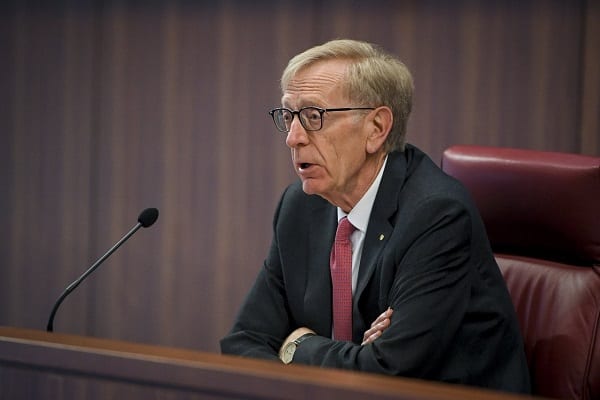Vital Lessons on Leadership from the Australian Banking Royal Commission

Kenneth Hayne (Image Credit Fairfax Media)
The implications from the Hayne Royal Commission will be picked over for many months, but there’s one immediate lesson that applies right now to every senior leader.
How you “show up” matters. And it matters a lot.
It certainly mattered for the National Australia Bank’s CEO Andrew Thorburn and chairman Ken Henry, who after being publicly rebuked in the Final Report of the inquiry into the financial services industry, finally had to step down.
At their appearances last year at the Commission, both men were notably more defensive in their demeanour than other leaders.
Henry’s performance, in particular, was described by journalists as “bullying”, “lecturing” and “dismissive”, and “misjudging the public’s mood”. Thorburn’s appearance was described as, at times, descending into absurdity and “evasive”.
In his final report, Commissioner Hayne concluded: “NAB also stands apart from the other three major banks. Having heard from both the CEO, Mr Thorburn, and the Chair, Dr Henry, I am not as confident as I would wish to be that the lessons of the past have been learned,” writes Hayne.
“More particularly, I was not persuaded that NAB is willing to accept the necessary responsibility for deciding, for itself, what is the right thing to do, and then having its staff act accordingly.
It was a damning assessment of one of Australia’s big four banks – all of which seems to be a direct consequence of how the top NAB executives showed up at the Commission hearings.
Of all the leadership attributes that needed to show up in the pressure cooker of judicial interrogation that was the Royal Commission, it appears that it was the absence of one attribute that mattered the most—humility.
To underscore the point, the bank bosses who did show contrition during the Commission hearings, an awareness of the damage done, and a willingness to take remedial action, dodged a bullet. Before his excoriating conclusions about NAB and its leaders, Hayne noted he was persuaded that Matt Comyn, CEO of CBA and Shayne Elliot, CEO of ANZ, were well aware of the size and nature of the tasks that lay ahead.
Last year the Governor of the Bank of England, Mark Carney, suggested four essential characteristics of leadership in a disruptive age: ambition (for the organisation), clarity, purpose, and, yes, humility.
What the NAB departures have demonstrated is that what sets humility apart from the other attributes on Carney’s list is that when humility is missing – or perceived to be missing – the negative effects can be huge.
In our experience of working with senior leaders who need to “show up” with positive impact in high-stakes scenarios, demonstrating humility doesn’t always come naturally. Or they are oblivious to its absence.
Last year, I had the opportunity to work with a number of leaders on managing themselves and their own internal state as they prepared to give evidence at the Royal Commission. Here are some guiding principles that I gave them—which seemed to serve them well:
1. Know your audience
There may have been several million people watching the Commission hearings, but in the end, each of the witnesses was speaking to an audience of one: Kenneth Hayne. The question each leader needed to ask is: “What are the Commissioner’s expectations of how I show up, and how do I make sure I meet those expectations?”
2. Align your intent with your audience’s expectations.
This is a hidden pitfall for many senior leaders. They often operate in environments where they need to be seen to be bullet proof. Their default setting is to dispense with the cloak of humility and replace it with the armour of invincibility. This does not play well with most audiences. Yet it is only in the unforgiving and high-stakes environment of a public inquiry that a bright light is shone on this blind spot. In the case of Henry and Thorburn that was too late.
3. Be your authentic self, or your body will betray you
Another blind spot for senior leaders is their ability to appear authentic. We tend to judge ourselves by intent. Yet others judge us by our behaviours. When there is an incongruence between these two things, it creates a perception of inauthenticity. And perception becomes the reality. Here’s an example of incongruence: a witness is thanking the counsel for their question while visibly bristling with indignation. These are ‘the moments of truth’ where what we are seeing and what we are hearing don’t quite match up. When there is a critical mass of these moments on incongruity, we unconsciously formulate a perception of “evasiveness” or “arrogance”.
It’s interesting to see how the Royal Commission has played out and the vital lessons on leadership that have emerged – including this one:
Even in the age of Trump, humility trumps arrogance.

About the Author:
Mehul Joshi ,Partner, Stephenson Mansell Group.
Mehul Joshi is a former award-winning BBC journalist and is now a sought-after consultant and executive coach in leadership development and employee engagement, with career spanning three decades and four continents.










